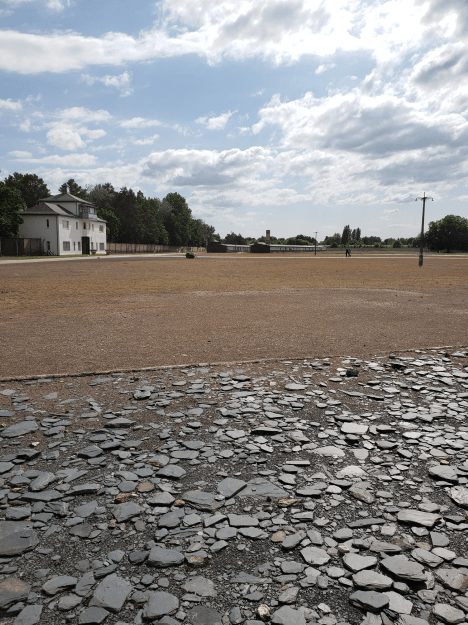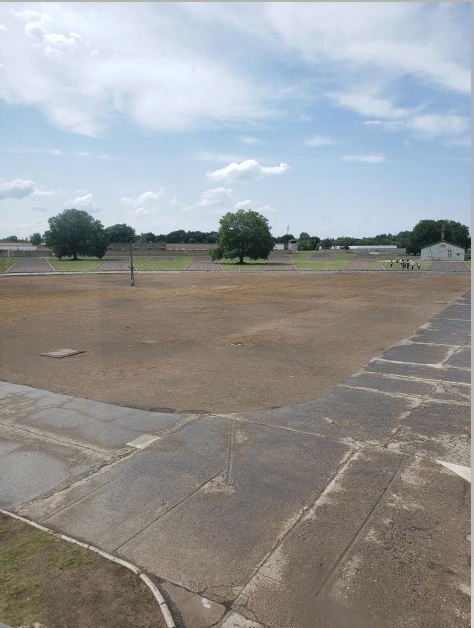Confronting Germany's Sinister History: Sachsenhausen Concentration Camp
On Wednesday we took one of our final and easily our most difficult excursion to the memorial of the Sachsenhausen concentration camp, just outside of Berlin. After a month of fun and exciting excursions, we had to keep one thing in mind: Today is not about fun. With much of the memorial standing in ruins and none of the conditions resembling those of the camp in the 30s & 40s, it wasn't quite possible for us to put ourselves into the mindset of the prisoners. We could learn it as history, but luckily for us, we could never be there. On this hard and emotional excursion, we stepped into the past to remember, it should stay in the past.

We experienced many luxuries today that those approaching the camp would have never been able to. We sat in comfortable seats on the regional train, rather than being crammed into cattle wagons too full to sit down. When we arrived at the Oranienburg Train Station, we were able to board a bus, rather than being forced to walk two kilometers under the watch of armed guards. When the pouring rain started, we were able to run inside a building rather than being forced to continue working and risk illness. The ominous sky upon arrival was fitting. Dark clouds blanketed the horizon over the houses which stood just feet from the camp. These homes would have been reserved for high ranking officials and SS guards. At the time, they were new and luxurious. Many young Germans were willing to do whatever it took to be awarded with one of these homes. The prisoners would walk on the street right in front of them when they arrived at the camp for the first time. It was a stark reminder to the other townspeople not to talk about the camp, lest they want to end up there as well.

As we entered through the gates, the infamous words greeted us. ,,Arbeit macht frei" "Work will make you free." This phrase was on the gates of most camps, but at Sachsenhausen, many believed it was true. Our tour guide Gregor taught us that it was originally opened as a labor camp, with the most people coming in as political prisoners from the Social Democratic & Communist Parties - Hitlers biggest opponents. Other types of prisoners were brought in as well, and they were identified by different colored triangles on their clothing. Many of them couldn't even speak German, but the SS guards found a cruel brand of humor in forcing them to read signs like the one pictured above and punishing them when they couldn't. It was no real surprise to learn that the guards took great pleasure in assaulting the prisoners, but to learn the lengths some of them went to be able to do that was sobering.

We heard the story of the day one prisoner escaped. When they were all lined up for their daily role call and someone was found out to be missing, the rest were forced to stand in place for 14 hours straight without moving a muscle. On a daily basis, some prisoners were forced to run the length of a marathon across rough terrain to test new boots for the military. Just walking across this pathway once was difficult, so we couldn't imagine the injuries prisoners would have sustained in doing this. We went inside one of the baracks that housed Jewish prisoners, who were often still viewed by other prisoners as being beneath them. We heard heartbreaking story after heartbreaking story, we found ourselves feeling sad and upset by the end of it. To conclude the tour, Gregor told us, "I'm not giving you this tour to make you feel sad or guilty. None of us are guilty for what happened here. But we should all feel a sense of responsibility to make sure something like this never ever happens again." Powerful words to help wrap up a powerful day. We commuted back to Berlin with this on our minds. A new perspective and a sense of responsibility, that there may never be more places like Sachsenhausen. Never again. Nie wieder.

Related Posts
Museum für Naturkunde Excursion
Berlin Language & Culture students visited the Museum für Museum für Naturkunde – Leibniz-Institut für Evolutions- und Biodiversitätsforschung (Museum of Natural History – Leibniz Institute for Evolution and Biodiversity Science)... keep reading
Exploring the Reichstag Dome
On Monday, students from the Language and Culture program had the opportunity of visiting the iconic dome atop the Reichstag, the seat of Germany’s federal parliament (the Bundestag). As they... keep reading
Sachsenhausen Memorial Visit
On Wednesday, students of the Language and Culture program visited the Sachsenhausen concentration camp. Students were very interested in learning about the history of the camp and how it came... keep reading









